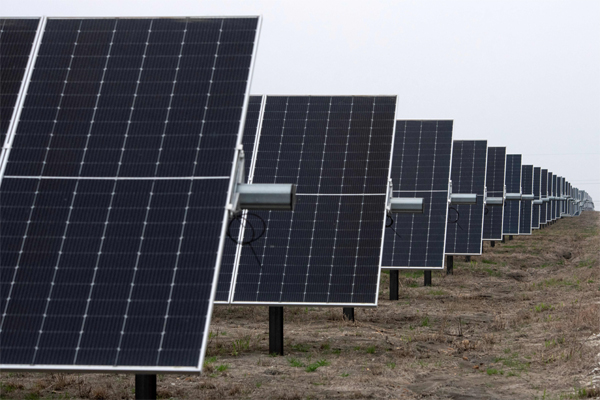
By Laura Sanicola
Solar is booming in the U.S., but picking sector winners is only getting tougher as new trade barriers take hold.
The industry is benefitting from consumer and corporate tax breaks in the Inflation Reduction Act. Demand is getting a lift from a drop in panel prices, while domestic panel production and installations are expanding. Solar has become the top source of energy for new power generation by utilities. There’s even an AI angle, thanks to growing power demand from data centers.
But the solar boom is being complicated by new rounds of tariffs on imports from Southeast Asia. A tariff moratorium on Southeast Asian panels and cells made with Chinese components ended June 6th. More tariffs could be coming next year from an anti-dumping and countervailing duties investigation on imports from Southeast Asia. Tarrifs could range from 50% to 270%. The region made up 84% of U.S. panel imports in the fourth quarter of 2023, according to S&P Global Market Intelligence.
Global prices are inching up in anticipation of stiffer trade barriers. According to data from OPIS, a Dow Jones company, prices for panels slated for delivery in August jumped 6.8% in the last month to 0.27 per watt. Prices for June 2025 deliveries are up 24% to $0.30 per watt.
Assuming higher prices stick, some companies should benefit while others face pressure. Companies with U.S. manufacturing like JinkoSolar and First Solar stand to gain. Higher prices for crystalline silicon photovoltaic cells—the most common type of cell—should boost their margins and solidify their market positions, said Pavel Molchanov, a clean-tech analyst at Raymond James. First Solar’s cadmium telluride thin-film solar modules aren’t subject to new tariffs, giving the company a competitive advantage, he added.
It’s a different story for installers that rely heavily on imported PV cells. Imports from Vietnam, for instance, could face tariffs as high as 270%. This would be a blow to SunRun and SunPower, which depend on affordable imports, said Molchanov.
“SunRun may have inventory to last them until the end of the year, but I’m sure they would prefer to have all these modules coming in, so that they can continue to grow the market and sell the panels at a low price,” said Hanwei Wu, editorial director at OPIS in Singapore.
SunRun and SunPower did not immediately respond to a request for comment.
For now, an inventory glut in North America should “soften the blow” for installers before higher prices kick in, said Mizuho analyst Maheep Mandloi.
Meanwhile, some production is shifting to countries that aren’t in the tariff crosshairs. China-based manufacturers Trina Solar and LONGi Green Energy Technology are investing in Indonesian facilities. But production costs will be higher than in China, while the majority of solar wafer manufacturing remains centralized in China.
Tariffs won’t be entirely positive for domestic manufacturers. JinkoSolar and LONGi, building plants in states like Ohio, need imported components that are still under scrutiny.
A domestic supply glut may be building. Mandloi estimates the U.S. could have more than 40 gigawatts of solar cell manufacturing operational in 2027, pushing the industry close to oversupply later this decade. That’s potentially negative for First Solar, though he still sees the stock reaching $274 over the next 12 months, from recent prices around $250.
While First Solar is doing well this year, the overall sector is struggling: The Invesco Solar ETF is down 18%.
Stocks and ETFs impacted: JinkoSolar (JKS), First Solar, SunRun (RUN), SunPower (SPWR), Invesco Solar ETF (TAN)
The Energy Roundup
Gasoline ↔ Prices at the pump have been stable, averaging $3.45 a gallon. But prices could dip below $3 a gallon by the end of the year, according to Tom Kloza, global head of energy analysis at OPIS. Volume surveys by OPIS suggest gas demand is down 1.3% year-over-year and was flat in the last week, Kloza said. Meanwhile, inventories look robust, sitting 10 million barrels higher than year-ago levels. A major hurricane hitting Gulf refineries would lift prices; absent that, we’re likely to see pump prices inch down this fall.
Stocks impacted: Marathon Petroleum (MPC), Valero Energy (VLO), Phillips 66 (PSX)
Plastics ↑ Prices for U.S. propylene, the raw material used to make polypropylene, are up 16% in the past month, an unusually large gain in a short time span, according to data from OPIS. Operating issues at several key plants in Texas have created a shortage of the raw material in recent weeks. A drought in Mexico increased plastic imports as petrochemical operations were spotty at certain manufacturing sites. Rising freight rates have hampered Aisan exports to Latin America. Prices are likely to fall as supply issues resolve in the coming weeks, but second quarter margins could take a hit.
Stocks impacted: Braskem (BAK), ExxonMobil (XOM), LyondellBasell Industries (LYB), TotalEnergies (TTE)
Natural gas ↑ A scorching start to summer including an East Coast heat dome has air conditioners working overtime. It’s also propping up prices for natural gas, a key source of fuel for utilities. Natural gas used for power generation rose by 4.5% over the past week, according to the EIA, while total U.S. consumption of natural gas rose by 1.7% compared with the previous reported week. Henry Hub natural gas futures held steady this past week, but are up 40% month-over-month.
Stocks and ETFs impacted: United States Natural Gas Fund (UNG), Cheniere Energy (LNG), Chesapeake Energy (CHK), Southwestern Energy (SWN), ONEOK (OKE)
Upstream ↑ The economics of upstream production are looking better as capital expenditures normalize and companies emphasize short-cycle projects with higher returns, according to Goldman Sachs. Much of the industry’s capex since 2020 has gone into projects like U.S. shale, deepwater drilling, and onshore infrastructure to alleviate bottlenecks, Goldman said. It’s a positive sign for dividend growth and buybacks. The downside: Production is likely to be depleted at a faster pace, falling to an average 21 years from 46 years in 2014.
Stocks and ETFs impacted: Shell (SHEL), Eni (E), Chevron CVX), ConocoPhillips (COP), ExxonMobil (XOM), iShares U.S. Oil & Gas Exploration & Production ETF (IEO)
_________________________________________________________
Laura Sanicola is a reporter at Barron’s. She covers energy and commodities and writes the Energy Insider newsletter. Laura was previously an energy reporter at Reuters and a business reporter at CNN and Euromoney. EnergiesNet.com does not necessarily share these views
Editor’s Note: This article was originally published as Special edition of The Barron’s Daily. Energy Insider, a deep dive into energy markets with exclusive insights from the award-winning team of commodity analysts at OPIS and analysis from Barron’s newsroom, on June 23, 2024. All comments posted and published on EnergiesNet or Petroleumworld, do not reflect either for or against the opinion expressed in the comment as an endorsement of EnergiesNet or Petroleumworld.
otice: This site contains copyrighted material the use of which has not always been specifically authorized by the copyright owner. We are making such material available in our efforts to advance understanding of issues of environmental and humanitarian significance. We believe this constitutes a ‘fair use’ of any such copyrighted material as provided for in section 107 of the US Copyright Law. In accordance with Title 17 U.S.C. Section 107. For more information go to: http://www.law.cornell.edu/uscode/17/107.shtml.
EnergiesNet.com 06 23 2024











